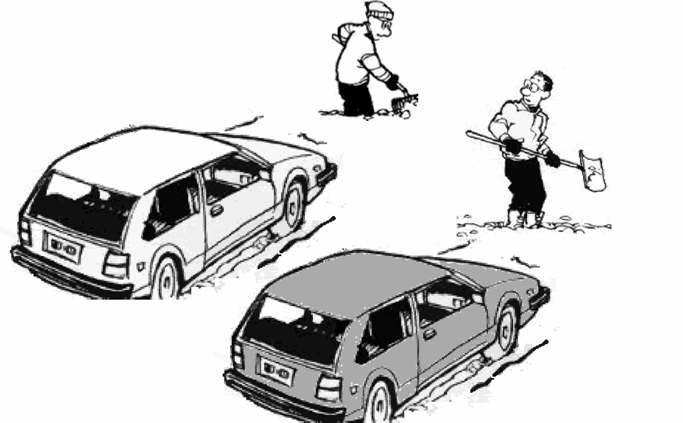SNOWDRIFT
From 2009.igem.org
| Line 2: | Line 2: | ||
{|align="justify" | {|align="justify" | ||
{{Team:IBB_Pune/menu}} | {{Team:IBB_Pune/menu}} | ||
| + | <BR> <BR> | ||
| + | |||
| - | |||
<p><span style="font-weight:bold; font-size:200%; color:#6600FF;">The Snowdrift Game</span></p> | <p><span style="font-weight:bold; font-size:200%; color:#6600FF;">The Snowdrift Game</span></p> | ||
Revision as of 05:37, 20 October 2009

| Co-operate | Defect | |
|---|---|---|
| Co-operate | b-c/2, b-c/2 | b-c, b |
| Defect | b, b-c | 0, 0 |
The 'payoffs' are organised as follows. The payoff of the row player is written first, so when the row-player co-operates and the column-player defects, the row-player gets a payoff of 'b-c', while the column-player gets 'b'.
So what do you do? As you can see it is best for you to defect (you lazy bum) assuming ofcourse, that the other player is willing to co-operate. However, if he is not, it is best for you to co-operate. Yeah, you pay the cost of shoveling, but something is better than nothing right? This is typical of the snowdrift game. There is no single best strategy. The best strategy here, depends upon what the other player is about to do. As seen above, the best outcome for you, is when you do the opposite of what the other player does.
Our Idea
We intend to simulate this system in vivo using engineered E.coli. The scheme is as follows:
The growth medium supporting bacterial growth consists of Lactose as the sole carbon source, mineral nitrogen source ammonium sulphate and other trace salts. Thus survival of each bacterium depends upon the ability to utilize lactose to fulfill its metabolic requirement.
Our initial population consists of two strains of E. Coli
Strain 1: (Defector Strain): LacZ -
Strain 2: (Co-operator Strain): Contains our construct.
The co-operators in the population have the ability to synthesize B-galactosidase enzyme constitutively. This enables them to metabolize intracellular lactose into glucose and galactose which are finally converted to usable forms of energy (ATP) which is essential for cell survival, growth and reproduction. The defectors in the population ( LacZ -) do not possess this ability. Thus they must depend upon other carbon sources. This is made available to them due to the presence of the export tag attached to the B-galactosidase enzyme. The export tag facilitates the diffussion of B-galactosidase into the extracellular environment via the TAT-export pathway. This causes the extracellular accumulation of B-galactosidase. The enzyme, active in the cell environment, will cleave lactose molecules into glucose and galactose, which freely diffuse throughout the medium. These molecules can be taken up by the defectors, "free of charge". Thus the growth of defector cells will be supported by the "co-operative" act of B-galactosidase secretion. If the population of co-operators is high, large amounts of extracellular B-galactosidase will accumulate leading to high amounts of extracellular glucose. This facilitates the growth of other defectors and co-operators as well. However, since the defectors do not have to pay the metabolic "cost" of producing and exporting the enzyme, they will have a slight growth advantage over the co-operators. This will lead to rise in defector numbers. However, if the number of defectors becomes too large, the co-operators can no longer produce enough B-galactosidase vis-a-vis glucose to support the entire population. The population would then begin to decline, and would favour the co-operators (who can use the intracellular lactose for their own growth) till the balance is restored.
The expected dynamics of this system would mimic those observed in the Snowdrift Game, in which co-operation is at an advantage in a population of defectors and vice-versa.
We intend to detect the relative proportion of defectors by measuring flourescence (GFP). Since GFP production is controlled by the same promoter as B-galactosidase, the amount of flourescent protein produced will be in proportion to the amount of enzyme produced, which will be proportional to the number of co-operators producing the enzyme. Thus we will be able to estimate the number of co-operators in the system and calculate their proportion relative to the defector numbers.
The game theoretic solution for a population steady-state is when the frequency of co-operators 'p' equals the ratio (b-c) / (b- c/2), where, 'b' is the 'benefit' (in terms of reproductive fitness) and 'c' is the 'cost' to the players.
Here, production of the enzyme and its subsequent export is a 'cost' to the co-operators. This 'cost' is not borne by the defector cells. The benefit is in terms of glucose molecules obtained (ATP molecules produced) which leads to increase in the growth rate of the cell. If the proportion of co-operators becomes (b-c) / (b- c/2), then the population would reach a steady-state in which the benefit of being a co-operator minus the cost would exactly equal the benefit to a defector. Since neither strain is at a competitive advantage, this ratio will be stabilized. In game theory jargon, this is called an Evolutionary Steady State (ESS).
There are several confounding factors, which need to be considered while postulating that such a steady state will actually be acheived in our system. One assumption is that the conditions are non-limiting, which may not be the case in our system. As the population grows, the levels of lactose would go down at an ever-increasing pace. This would change the final dynamics and the stable ratios obtained. Again, such stable ratios are obtained after several generations of balancing selection. This would mean that the experiment needs to be carried out under invariant conditions for several generations before the ESS is actually acheived. These and other complications are considered in the modelling section.
 "
"
